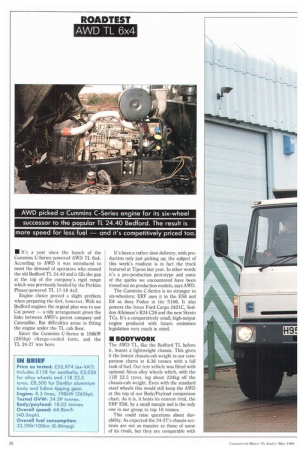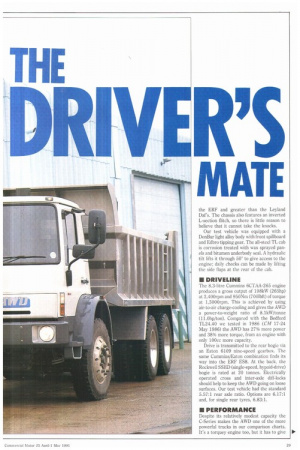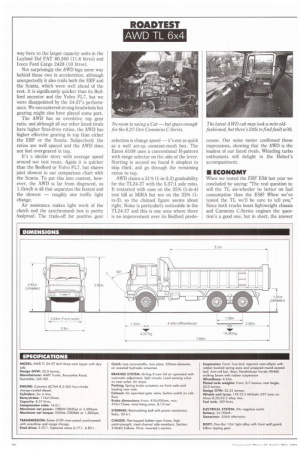• It's a year since the launch of the Cummins
Page 30

Page 31

Page 32

Page 33

If you've noticed an error in this article please click here to report it so we can fix it.
C-Series powered AWD TL 6x4. According to AWD it was introduced to meet the demand of operators who missed the old Bedford TL 24.40 and it fills the gap at the top of the company's rigid range which was previously headed by the Perkins Phaser-powered TL 17-18 4x2.
Engine choice proved a slight problem when preparing the 6x4, however. With no Bedford engines the orginal plan was to use Cat power — a tidy arrangement given the links between AWD's parent company and Caterpillar. But difficulties arose in fitting the engine under the TL cab floor.
Enter the Cummins C-Series in 198kW (265hp) charge-cooled form, and the TL 24-27 was born. It's been a rather slow delivery, with production only just picking up; the subject of this week's roadtest is in fact the truck featured at Tipcon last year. In other words it's a pre-production prototype and some of the quirks we encountered have been ironed out on production models, says AWD.
The Cummins C-Series is no stranger to six-wheelers: ERF uses it in the ES8 and E8 as does Foden in the S106. It also powers the Iveco Ford Cargo 2421C, Seddon Atkinson's R24 C26 and the new Strato TCs. It's a comparatively small, high-output engine produced with future emissions legislation very much in mind.
The AWD IL, like the Bedford TL before it, boasts a lightweight chassis. This gives it the lowest chassis-cab weight in our comparison charts at 6.36 tonnes with a full tank of fuel. Our test vehicle was fitted with optional Alcoa alloy wheels which, with the 11R 22.5 tyres, lop about 224kg off the chassis-cab weight. Even with the standard steel wheels this would still keep the AWD at the top of our Body/Payload comparison chart. As it is, it beats its nearest rival, the ERF ES8, by a small margin and is the only one in our group to top 18 tonnes.
This could raise questions about durability. As expected the 24-27's chassis sections are not as massive as those of some of its rivals, but they are comparable with the ERF and greater than the Leyland Des. The chassis also features an inverted L-section flitch, so there is little reason to believe that it cannot take the knocks.
Our test vehicle was equipped with a DonBur light alloy body with front spillboard and Edbro tipping gear. The all-steel TL cab is corrosion treated with wax sprayed panels and bitumen underbody seal. A hydraulic tilt lifts it through 50' to give access to the engine: daily checks can be made by lifting the side flaps at the rear of the cab.
The 8.3-litre Cummins 6CTAA-265 engine produces a gross output of 198kW (265hp) at 2,400rpm and 950Nm (700Ibft) of torque at 1,5000rpm. This is achieved by using air-to-air charge-cooling and gives the AWD a power-to-weight ratio of 8.1kW/tonne (11.0hp/ton). Compared with the Bedford TL24.40 we tested in 1986 (CM 17-24 May 1986) the AWD has 27% more power and 38% more torque, from an engine with only 100cc more capacity.
Drive is transmitted to the rear bogie via an Eaton 6109 nine-speed gearbox. The same Cummins/Eaton combination finds its way into the ERF ES8. At the back, the Rockwell SSHD (single-speed, hypoid-drive) bogie is rated at 20 tonnes. Electrically operated cross and inter-axle diff-locks should help to keep the AWD going on loose surfaces. Our test vehicle had the standard 5.57:1 rear axle ratio. Options are 6.17:1 and, for single rear tyres, 6.83:1.
Despite its relatively modest capacity the C-Series makes the AWD one of the more powerful trucks in our comparison charts. It's a torquey engine too, but it has to give way here to the larger capacity units in the Leyland Daf FAT 80.260 (11.6 litres) and Iveco Ford Cargo 2428 (10 litres).
Not surprisingly the AWD lags some way behind these two in acceleration, although unexpectedly it also trails both the ERF and the Scania, which were well ahead of the rest. It is significantly quicker than its Bedford ancestor and the Volvo FL7, but we were disappointed by the 24-27's performance. We encountered strong headwinds but gearing might also have played some part.
The AWD has an overdrive top gear ratio, and although all our other listed rivals have higher final-drive ratios, the AWD has higher effective gearing in top than either the ERF or the Scania. Subjectively the ratios are well spaced and the AWD does not feel overgeared in top.
It's a similar story with average speed around our test route. Again it is quicker than the Bedford or Volvo FL?, but shares joint slowest in our comparison chart with the Scania. To put this into context, however, the AWD is far from disgraced, as 1.1km/h is all that separates the fastest and the slowest — roughly one traffic light change.
Air assistance makes light work of the clutch and the synchromesh box is pretty foolproof. The trade-off for positive gear selection is change speed — it's not as quick as a well set-up constant-mesh box. The Eaton 6109 uses a conventional H-pattern with range selector on the side of the lever. Starting in second we found it simplest to skip third, and go through the remaining ratios to top.
AWD claims a 31% (1-in-3,2) gradeability for the TL24-27 with the 5.57:1 axle ratio. It restarted with ease on the 25% (1-in-4) test hill at MIRA but not on the 33% (1in-3), so the claimed figure seems about right. Noise is particularly noticeable in the TL24-27 and this is one area where there is no improvement over its Bedford prede cessor. Our noise meter confirmed these impressions, showing that the AWD is the loudest of our listed rivals . Whistling turbo enthusiasts will delight in the Holset's accompaniment.
When we tested the ERF ES8 last year we concluded by saying: "The real question is: will the TL six-wheeler be better on fuel consumption than the ES8? When we've tested the TL we'll be sure to tell you." Since both trucks boast lightweight chassis and Cummins C-Series engines the question's a good one, but in short, the answer is no. On average the AWD used 8.6% more fuel than the ERF around our tipper test route. In fact it comes bottom in our comparison chart, using more fuel than either the Cargo or the Constructor which both have larger engines.
It seems that a comparatively small, hard working engine loses out to its lower stressed rivals, with the Cummins L10powered Cargo 2428 returning the best fuel consumption in our chart.
The AWD should, however, prove to be a winner with most drivers. The steering is pleasantly weighted with the right amount of assistance. Our test vehicle had a tendency to judder on full lock, but AWD assures us that this is a peculiarity not found on production models.
We were also impressed with the AWD's road behaviour. Roll is well controlled thanks to the front anti-roll bar and Hendrickson-Norde rubber suspension fitted to the rear bogie. The optional Michelin XZY HR 22.5 on/off-road tyres provided plenty of grip; 295/80R 22.5 highway tyres are standard fittings.
Our test route provides some poor road surfaces on the A-road section which are particularly good for assessing ride quality.
Even over the worst section we managed (283;4
to keep our seats so it seems that the right ride and handling compromise has been achieved. The driver also benefits from the standard Isringhausen air/ well in our panic stop, pulling the TL up in a straight line and in a shorter distance than our listed rivals. Exhaust brakes usually perform better with assistance from a down-change or two and the AWD's is no exception. We thought that the control could have been better positioned on the cab floor too. The parking brake held on the Five years on from our last TL six-wheeler test and the compact cab has changed little. It has a slightly old-fashioned feel to it, probably because it can trace its origins back to the TK in the early sixties. This does not imply criticism, however; as a day cab it has few shortcomings.
Stowage space is plentiful with a deep, moulded parcel shelf across the back of the cab. There's more room in the headlining shelf over the windscreen which includes space for a radio. A console tray behind the gearlever will hold smaller oddments, while the door pockets are designed to contain spare tacho charts.
























































































































